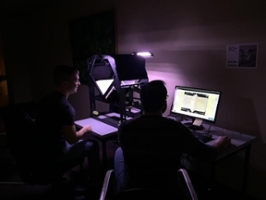Bringing Scranton’s History into the 21st Century and to the World

Once upon a time, if a modern-day Scrantonian wanted to learn about something that happened in the city a hundred years ago, he or she would have had to put in time and labor at the local library. Remember sifting through miles of microfilm, carefully winding and rewinding reels? Such an antiquated, analog world has now become highly digitized, making instant information more accessible than ever.
Kristen Yarmey, University of Scranton associate professor and digital services librarian at the Weinberg Memorial Library, wanted to celebrate that fact – along with the city of Scranton’s 150th anniversary this year – by pulling the past farther into the future in a cutting-edge way that would put the University of Scranton in the limelight of the library world.
Knowing the city sesquicentennial was approaching, Yarmey explained, several historically minded individuals and groups – representing the Scranton Public Library, the Weinberg Memorial Library, the University’s History Department, the Lackawanna Historical Society, and the Royals Historical Society (student history club)– put their heads together during the summer.
“We wanted to do something special, some kind of digital-history project,” she said.
From that meeting of minds, the first-of-its-kind, prototype-style Scanathon, which took place Oct. 24 and 25 at the Weinberg Memorial Library, was born. The intent? In a nutshell, to engage in the ongoing, monumental process of digitizing local history by scanning a trove of significant papers. Adam Pratt, Ph.D., assistant professor of history at the University and moderator of the Royals Historical Society, credits Yarmey for “her idea, organization and energy that got the ball rolling” on what ultimately proved a successful, replicable, cross-disciplinary project poised to put the public in closer-than-ever contact with history, specifically that of city patriarchs the Scranton family. Enter The Scranton Family Papers, what Yarmey calls “a really huge collection” housed at the Lackawanna Historical Society. It spans the years 1850 to 1917 and includes 19 bound volumes and over 9,000 letters, written by George W. Scranton, Joseph Hand Scranton and William Walker Scranton.
To scan and digitize all of these would be an insurmountable task in a weekend, so Yarmey and crew – 30 student volunteers and seven staff members from the University, Scranton Public Library and Lackawanna Historical Society – began with a meaningful but manageable batch.
“We decided to start with the first two volumes: George W’s letters from 1850-1854,” Yarmey said, noting that much of the content is business correspondence. The volumes were loaned from the Historical Society to the Weinberg Memorial Library for the Scanathon.
“This was a really important time in the city of Scranton,” she said, explaining that all the railroads were under way and, because industry was ramping up, labor issues were cropping up.
The period thoughts put to paper by the city’s founding fathers are accordingly rich and revealing. Dr. Pratt said they also are captivating if for the simple reason that people “wrote and spoke in a way we do not anymore.”
“It’s always amazing, when you read anything from the 19th century, how eloquent they were,” he said, noting the letters also are fascinatingly different for each family member.
Some of the Scrantons were “so into the railroads, coal or labor disputes,” Dr. Pratt said, while “others were just normal people interested in family life.”
At the first Scanathon, students also created metadata, or descriptive information, for the George W. Scranton letters, Yarmey said.
“Whenever you scan something, you want to know who wrote this, who it was to, what date it was written, what was the letter about,” she explained.
Students will create spreadsheets to match up everything scanned, and the Weinberg Memorial Library will work with the Scranton Public Library to make everything available to the public.
Yarmey is quick to point out the intrinsic value of the efforts for students. “Digitization has changed the field of history,” she said. “It’s a really hands-on opportunity for students to try out some new skills.”Yarmey said the volunteers successfully digitized both volumes of George W. Scranton’s letters as well as more than 300 pages of loose Scranton family correspondence.
“Overall, we created 1,608 digitized images (over 20 GB), which will now be processed and prepared for publication in the Internet Archive and the Lackawanna Valley Digital Archives,” she said.
Those archives are a searchable database of digitized materials hosted by the Scranton Public Library. The digitized volumes are already live on Internet Archive (Volume 1, Volume 2).
Dr. Pratt puts it simply: “They make Scranton history accessible all over the globe. We’re bringing Scranton to the rest of the world.”
A successful first effort, maps the territory for future efforts. The partners are considering the possibility of a second, larger Scananthon this spring, in which the public will be invited to bring in all manner of documents and photographs for digitization.